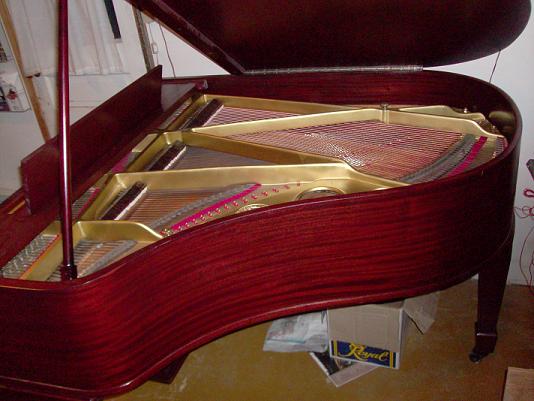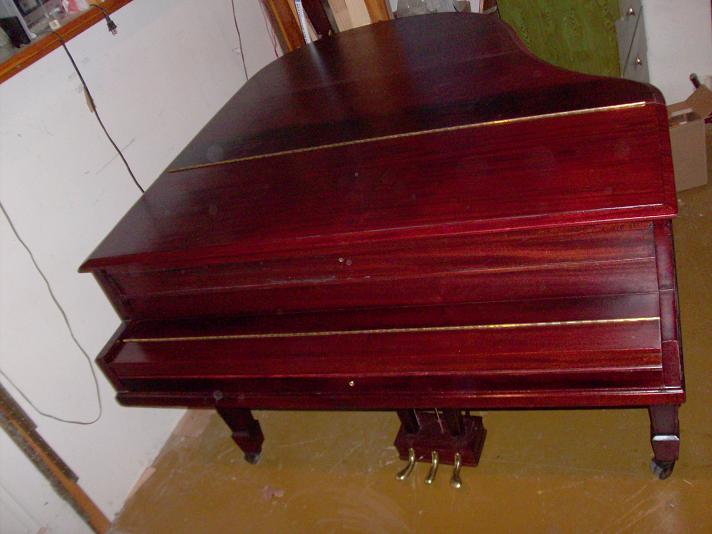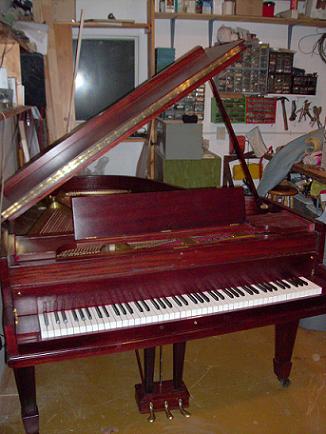|
Rebuilt Mason and Risch Grand PianoThis grand piano was originally built in Toronto just after 1900. When I received it, it had suffered much abuse. Some hammers were missing and action parts were broken. The bass strings were extremely dull and the pin-block was badly cracked. The sound-board needed some repair and the case of the piano was damaged with some broken parts. I enjoyed taking a piano that was practically worthless and bringing it back to a lovely instrument to play and listen to. Needless to say it needed to have almost everything replaced or repaired. The new German Abel hammers I installed give it a warm mellow sound. It is now being used in a high-school music program. You can get some idea of the transformation by looking at the before and after pictures. At this point I will take the opportunity to briefly discuss the repairs made to this rebuilt grand piano. In order to replace the pin-block in a grand piano, it is necessary to remove all strings, dampers and their guide rail, and the cast iron plate. There will then be access to the pin-block. Any sound-board repairs are done at this time. The body of the piano is then repaired and refinished. The new pin-block must be shaped exactly like the original and all the 200 plus holes for the tuning-pins must be in exactly the correct place. The iron plate is cleaned and painted. The plate and block are then placed in the piano and re-secured to the body. Next, the piano is restrung with new strings and tuning pins. Tension is put on the strings and the piano is tuned again. It takes a number of tunings before the piano is stable. If a piano still has ivory keys in good condition, with perhaps a few missing or broken ones, it makes sense to repair and clean. After any necessary repairs have been done, the key-tops can be buffed. This will give them a lovely satiny feel. However, this is not very often the case. Often you will find that many of the key-tops are missing or broken. This makes it very difficult to get consistent colouring and feel to the key-board. In these cases it makes more sense, both from a financial and an aesthetic perspective, to replace them with plastic key-tops with fronts attached. This will give a clean, new, and consistent appearance. The type of keys that have the fronts already attached to the upper portion look good and tend to stay glued more permanently. The Mason and Risch piano had already had the ivories replaced by plastic key tops, but these needed to be replaced because of their poor condition. The key-bed felt is found under the keys. There is a strip of felt at the back of the keys and a small circle of felt at the balance rail or middle rail, and larger thicker circles of felt at the front rail. Occasionally, the felt is still in reasonable condition after even a hundred years. This will only be the case if the piano has been kept in a very clean and dry environment. Very often the felt is packed and hardened and moth-eaten or damaged by mice. In these cases, it is necessary to remove old felt and clean the key-bed very well. The new felt is then set in place. There are different thicknesses available, so it is necessary to use the correct ones for the piano. After this is done, the keys are leveled and the correct key-dip or key travel is established by means of paper punchings or spacers, to compensate for inconsistencies in the key, key bed, or the felt. In the case of a rebuilt grand piano, it is standard practice to replace the key bed felt. Hammers are a very important element in producing a pleasant piano sound in any rebuilt grand piano. Hammers are made by forcing a thick layer or several layers of felt around a wooden molding. The angle is very sharp, and it takes great force. The felt is then glued and sometimes stapled in place. This forcing gives the hammer its character. The felt closest to the wood molding is greatly compressed and the felt on the outer surface is under great tension or stress. When these hammers are properly voiced, the sound will continue to build for a moment after the string is struck before the sound starts to die away. An old or badly voiced hammer will have harsher, brittle sound at impact and then die away immediately. Old hammers can be muffled or inconsistent as you move up or down the key-board. A new set of hammers can do a great deal in restoring a piano to its original beautiful sound. The sound-board is also critical in producing a good quality tone. It must have crown, which means that it is slightly higher in the center than it is around the edges, and the bridges rest on the crowned area. The bridges transfer the sound of the strings to the sound-board. It is essential that the sound-board and bridges are secure at all glue joints so there will be no buzzes or loss of sound. If there are cracks, additional repairs will be required. New dampers are always required on a rebuilt grand piano. The new felt on the dampers will fit perfectly to the new strings allowing strings to be damped very effectively when the strings are not being played. The pianist will enjoy this control of sound while performing. The last (and an extremely important) part of the project, after all repairs and replacement of parts has been done, is to finely regulate the rebuilt grand piano. There are many points of adjustment on the piano action and damper assembly. Some of these adjustments are very fine, down to thousands of an inch. A rebuilt grand piano will provide thousands of hours of service. It is important to have it serviced regularly and have periodic regulation done in the piano. This will provide for your maximum enjoyment of the instrument.







|